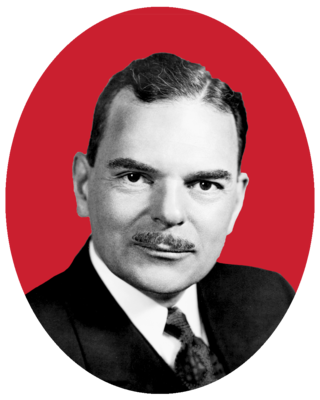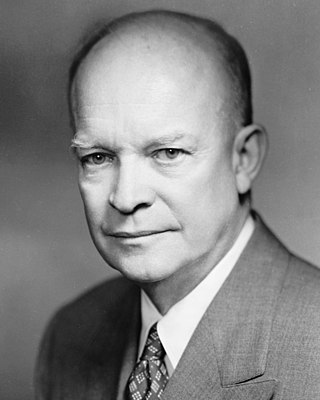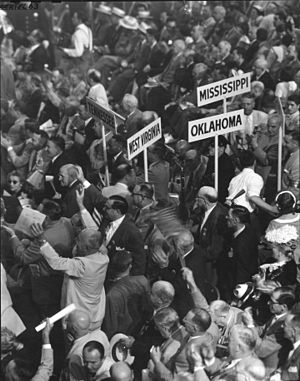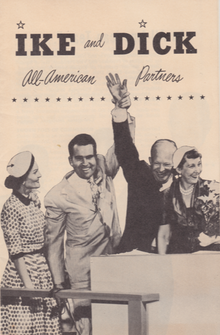
The 1948 United States presidential election was the 41st quadrennial presidential election. It was held on Tuesday, November 2, 1948. In one of the greatest election upsets in American history, incumbent Democratic President Harry S. Truman defeated heavily favored Republican New York Governor Thomas E. Dewey, and third-party candidates, becoming the third president to succeed to the presidency upon his predecessor's death and be elected to a full term.

The 1952 United States presidential election was the 42nd quadrennial presidential election. It was held on Tuesday, November 4, 1952. Republican Dwight D. Eisenhower defeated Democratic Illinois Governor Adlai Stevenson II in a landslide victory, becoming the first Republican president in 20 years. This was the first election since 1928 without an incumbent president on the ballot.

The 1956 United States presidential election was the 43rd quadrennial presidential election. It was held on Tuesday, November 6, 1956. Incumbent Republican President Dwight D. Eisenhower and his running mate, incumbent Vice President Richard Nixon, were re-elected, defeating for a second time Democrat Adlai Stevenson II, former Illinois governor. This election was the sixth rematch in American presidential history, a situation which would not occur again until 2024. It was the second time in which the winner was the same both times, the first being William McKinley's victories over William Jennings Bryan in 1896 and 1900. This was the last election before term limits established by the 22nd Amendment, which applied to Eisenhower, were effective.

Harold Edward Stassen was an American Republican Party politician, military officer, and attorney who was the 25th governor of Minnesota from 1939 to 1943. He was a leading candidate for the Republican nomination for president of the United States in 1948. Though he was considered for a time to be the front-runner, he lost the nomination to New York governor Thomas E. Dewey. He thereafter regularly continued to run for the presidency and other offices, such that his name became most identified with his status as a perennial candidate.

William Fife Knowland was an American politician and newspaper publisher. A member of the Republican Party, he served as a United States Senator from California from 1945 to 1959. He was Senate Majority Leader from August 1953 to January 1955 after the death of Robert A. Taft, and would be the last Republican Senate Majority Leader until Howard Baker in 1981.

The 1948 Republican National Convention was held at the Municipal Auditorium, in Philadelphia, Pennsylvania, from June 21 to 25, 1948.

The Draft Eisenhower movement was a widespread political movement that eventually persuaded Dwight D. Eisenhower, former Chief of Staff of the United States Army, to contest the presidency of the United States.

The 1956 Republican National Convention was held by the Republican Party of the United States at the Cow Palace in San Francisco, California, from August 20 to August 23, 1956. U.S. Senator William F. Knowland was temporary chairman and former speaker of the House Joseph W. Martin Jr. served as permanent chairman. It renominated President Dwight D. Eisenhower and Vice President Richard M. Nixon as the party's candidates for the 1956 presidential election.

The 1944 Republican National Convention was held in Chicago, Illinois, from June 26 to 28, 1944. It nominated Governor Thomas E. Dewey of New York for president and Governor John Bricker of Ohio for vice president.
The 1940 Republican National Convention was held in Philadelphia, Pennsylvania, from June 24 to June 28, 1940. It nominated Wendell Willkie of New York for president and Senator Charles McNary of Oregon for vice president.

Riley Alvin Bender was a United States businessman and political candidate.

From March 11 to June 3, 1952, delegates were elected to the 1952 Republican National Convention.

From March 9 to June 1, 1948, voters of the Republican Party elected delegates to the 1948 Republican National Convention, in part to choose the party nominee for president in the 1948 United States presidential election.

From March 10 to June 2, 1964, voters of the Republican Party elected 1,308 delegates to the 1964 Republican National Convention through a series of delegate selection primaries and caucuses, for the purpose of determining the party's nominee for president in the 1964 United States presidential election.

Electoral history of Robert A. Taft, United States Senator from Ohio (1939–1953), United States Senate Majority Leader (1953) and a candidate for the 1940, 1948 and 1952 Republican presidential nominations.

From March 14 to June 11, 1944, voters of the Republican Party selected delegates to the 1944 Republican National Convention for the purpose of selecting their nominee for president in the 1944 election at the 1944 Republican National Convention held from June 26 to June 28, 1944, in Chicago, Illinois.

Senator Richard M. Nixon's speech at a state Republican Party fundraiser in New York City on May 8, 1952, impressed Governor Thomas E. Dewey, who was an Eisenhower supporter and had formed a pro-Eisenhower delegation from New York to attend the national convention. In a private meeting after the speech, Dewey suggested to Nixon that he would make a suitable vice presidential candidate on the ticket with Eisenhower.

This article lists those who were potential candidates for the Republican nomination for Vice President of the United States in the 1944 election. At the start of the 1944 Republican National Convention, New York Governor Thomas Dewey seemed like the likely presidential nominee, but his nomination was not assured due to strong support for Ohio Governor John W. Bricker and former Minnesota Governor Harold Stassen. Though Dewey wanted California Governor Earl Warren as his running mate, Warren was convinced that Franklin D. Roosevelt would win re-election, and refused to be anyone's running mate. Some Republicans wanted to ask Democratic Senator Harry Byrd of Virginia to be the Republican running mate in order to pursue the Southern vote, but this possibility was not seriously pursued. Dewey and his advisers instead worked out a deal in which Bricker's delegates voted for Dewey in the presidential ballot, and Dewey in return chose Bricker as his running mate. The Dewey–Bricker ticket, which balanced the moderate Northeastern and conservative Midwestern wings of the party, was ratified by the Republican convention. The ticket lost the 1944 presidential election to the Roosevelt–Truman ticket.
In his political career, between the years 1938 and 1994, Harold Stassen, a Republican, ran many campaigns for public office. He was elected governor of Minnesota three times, in 1938, 1940, and 1942.



































